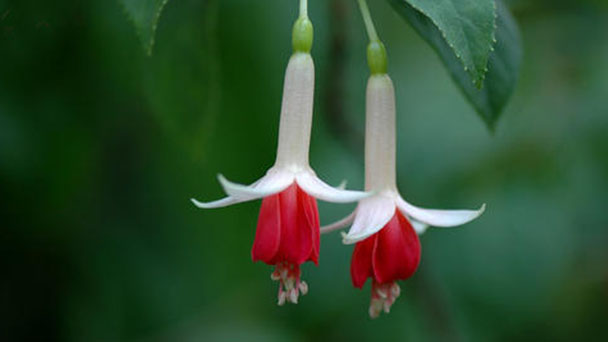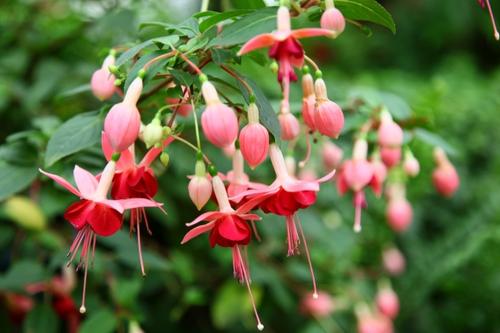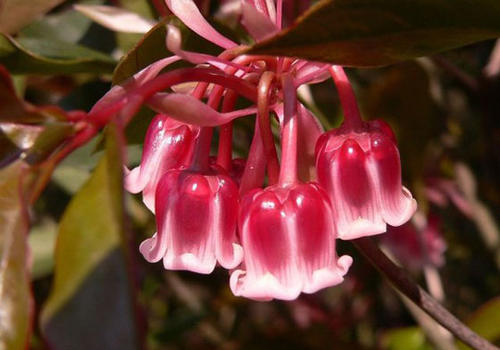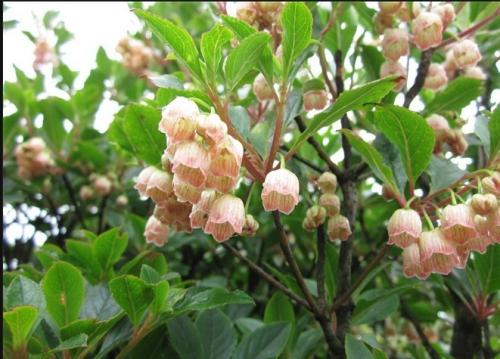Enkianthus perulatus profile
Written by Maggie
Feb 10 2021

Enkianthus perulatus is a deciduous shrub or small tree, usually 3 m tall, with yellowish bark; Enkianthus perulatus is much branched, branches terete, glabrous.
Enkianthus perulatus picture

Enkianthus perulatus morphological characteristics
Leaves: Leaves of enkianthus perulatus are often dense at branch apices, alternate, leathery, glabrous on both surfaces, oblong or ovate-oblong, reticulate veins evident on both surfaces; Morphological characteristics leaves are 6 -- 12 cm long, 2 -- 4 cm wide, apex acuminate and obtuse or apiculate, base attenuate, entire.
Flowers: Umbel terminal, 5-8 flowers on the inflorescence, flowers drooping; Flowers of enkianthus perulatus grow from large red bracts imbricate at branch apices, bracts oblong-elliptic, spatulate or linear-lanceolate, bracts reddish, membranous; Pedicels are 1 -- 2 cm long, green, glabrous; Calyx of Enkianthus perulatus is red, calyx 5-lobed, lobes triangular, 2 -- 4 mm long, lobes retro voluminous. Corolla is broadly campanulate, pink or red, ca. 1.2 cm. Enkianthus perulatus has 10 stamens, shorter than corolla, filaments flattened, white, pilose, anthers yellow; Ovary of Enkianthus perulatus is ovoid, 5-ridged, glabrous, style ca. 5 mm, glabrous.
Fruit: Capsule of Enkianthus perulatus is oblong, yellowish, ca. 1 cm long, 5-ribbed, fruit erect, stout, green, 3 -- 5 mm long, glabrous, apex with persistent style.
Enkianthus perulatus growth habit
Enkianthus perulatus is born in thickets on slopes 600 ~ 2400m above sea level. Enkianthus perulatus likes a cool, humid environment, can not tolerate hot and high temperatures, and the suitable temperature for growth is 15 ~ 20℃.
Enkianthus perulatus propagation
Layering propagation
Take a strong branch of Enkianthus perulatus and peel off the bark about 15 to 30cm below the top. The width of the wound after peeling should be about one centimeter, and the depth should be limited to the skin just peeled off. Cut a piece of film 10 ~ 20cm long and 5 ~ 8cm wide, put some wet garden soil on it, and wrap up the part of the ring peel as if wrapping a wound. Tie the upper and lower ends of the film tightly, and bulge up in the middle. Root in about four to six weeks. After Enkianthus perulatus takes root, the edge of the branch root system cuts together, becoming a new plant.
Cuttings
Enkianthus perulatus can be propagated from cuttings throughout the year, rooting faster in spring and autumn. Cut to the top of the best twigs, long 7 -8 cm, inserted in the sand bed, keep wet, inserted about 10 days after the root, can be on the basin in autumn. Potted soil for Enkianthus perulatus should be loose, fertile and good drainage, water prone to rot root death. Spring, autumn growth is rapid, every ten days fertilizes 1 time. High temperature in summer, stop fertilization. Place Enkianthus perulatus in a ventilated and cool place, avoid strong light in midsummer. Water frequently to increase air moisture. The branches of Enkianthus perulatus upside down are weak and drooping, and need to pick the heart to make them branch, and move less in the flowering period to prevent falling buds and flowers.
Division
The growth period of Enkianthus perulatus requires a cool climate, preferably at 10 ~ 15℃. Winter requires sufficient sunshine, can withstand the low temperature of 3 ~ 5℃; Summer in a semi-dormant state, avoid hot, like half shade. Shading is needed from spring to autumn in the south, and the growth is most rapid when the temperature is 15-23 °C. Only leave the base 20cm, so that the new shoots of Enkianthus perulatus are conducive to a safe summer.

Enkianthus perulatus growing methods
1. Soil: Enkianthus perulatus likes loose sandy loam with good drainage.
2. Water: winter and rainy season 2 ~ 3 days watering once.
3. Sunshine: Enkianthus perulatus like the environment of sufficient sunshine, lack of sunshine easy to grow, resulting in the reduction of flowering.
4. Fertilizer: apply organic fertilizer before transplanting, control nitrogen fertilizer in early growth period to prevent barren growth, and increase phosphorus and potassium fertilizer in flowering period.
5. Temperature: the suitable temperature for Enkianthus perulatus growth is 15 ~ 25℃, afraid of hot and high temperature in summer, the temperature exceeds 30℃, it will enter a semi-dormant state, winter shall not be less than 5 degrees.
Enkianthus perulatus pest control
Enkianthus perulatus is a frequent occurrence of wilt and rust, so 400 times of 20% rust emulsion is sprayed to prevent and control rust, and 1000 times of 10% antimicrobial 401 liquid is applied to the soil to prevent and control wilt. Ventilation is not good, easy to occur aphids, scale insects and whitefly harm, can be used 40% oxidized music emulsion 1000 times liquid spray kill.
Enkianthus perulatus flower language
The beauty of the hidden.

Latest Updated
- Benefits of Bugleweed - 7 Science-backed Health Benefits
- Bugleweed Dangers & Side Effects - Is It Poisonous?
- How to Plant Evergreen Trees - What You Should Know
- When to Plant Evergreens - Grow Guide for Evergreen Trees
- 12 Wonderful Evergreen Shrubs for Your Garden
- 12 Popular Evergreen Plants with Pictures for Beginners
- When And How To Prune A Lilac Bush Like a Pro
- How to Grow & Care for Lilac Vine (Hardenbergia Violacea)
- Japanese Lilac Tree (Syringa Reticulata) Care & Propagation Guide
- Shumard Oak Pros and Cons - What to Know
Popular Articles
- Winter maintenance of Antirrhinum Majus
- How to Grow Terminalia Mantaly Tree
- How to Grow and Care for Crossostephium Chinense
- How to grow Antirrhinum Majus in spring
- Peristeria Elata (Dove Orchid) Profile: Info & Care Guide
- Underwatered Snake Plant (Sansevieria Trifasciata) - Signs And How To Fix
- How to Care for Brazilian Jasmine Plant (Mandevilla Sanderi)
- How to Grow & Care for Graptopetalum Purple Delight in Summer
- Rosa Chinensis (China Rose): Plant Growing & Care Tips
- How to Care for Baby Sun Rose (Aptenia Cordifolia)